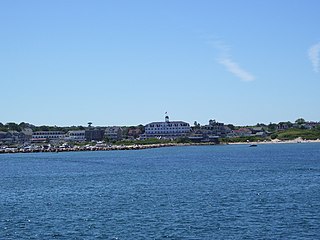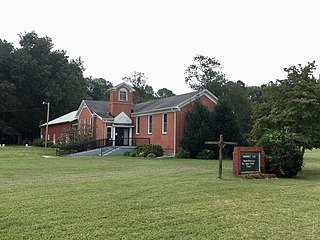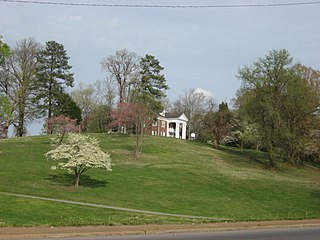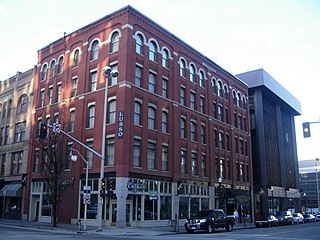
Clarksville is the county seat of Montgomery County, Tennessee, United States. It is the fifth-largest city in the state behind Nashville, Memphis, Knoxville, and Chattanooga. The city had a population of 132,929 at the 2010 census, and an estimated population of 158,146 in 2019.

Sevierville is a city in and the county seat of Sevier County, Tennessee, located in Eastern Tennessee. The population was 14,807 at the 2010 United States Census and 17,117 according to the 2019 census estimate.

The Leaf-Chronicle is a newspaper in the state of Tennessee, founded, officially, in 1808.

The original campus of Centenary College of Louisiana is located along College Street in Jackson, Louisiana. It is operated and preserved as a museum by the Louisiana Office of State Parks as the Centenary State Historic Site, offering educational interpretive programs and guided tours.

The Clarksville Historic District in Austin, Texas, is an area located west of downtown Austin near Lady Bird Lake and just northeast of the intersection of the Missouri Pacific Railroad and West Tenth Street. Many historic homes and structures are located within the Clarksville Historic District. While Clarksville is geographically part of the Old West Austin Historic District, it is distinct from the two historic neighborhoods of Old Enfield which lies immediately to the north on the eastern side of Texas State Highway Loop 1 and Tarrytown which is situated to the west and northwest on the western side of Mopac.

Quaker Square was a shopping and dining complex located in downtown Akron, Ohio which is now used by the University of Akron. Quaker Square was the original Quaker Oats factory; the complex consists of the former mill, factory, and silos. The buildings were bought in the early 1970s by developers who sought to create a unique, useful home for shops and restaurants. The buildings were bought by the University of Akron in 2007. The hotel has been converted to a residence hall. The retail space consisted of several small shops and restaurants, while offices were on the floors above. Quaker Square was open to the general public until September 18, 2015. The hotel no longer accepts reservations as the former hotel rooms and the entire complex is operated exclusively for student and university use. However, ballrooms are still available for catered events and conferences.

The Old Harbor Historic District is an historic district in the resort community of New Shoreham on Block Island off the southern coast of Rhode Island. Bounded by the Atlantic Ocean and Main Street, it includes Spring, High, and Water streets as well. There are 42 buildings listed in the district, which was listed on the National Register of Historic Places in 1974.

There are nine historic districts in Meridian, Mississippi. Each of these districts is listed on the National Register of Historic Places. One district, Meridian Downtown Historic District, is a combination of two older districts, Meridian Urban Center Historic District and Union Station Historic District. Many architectural styles are present in the districts, most from the late 19th century and early 20th century, including Queen Anne, Colonial Revival, Italianate, Art Deco, Late Victorian, and Bungalow.

The Waumbek Cottages Historic District encompasses a collection of high-quality summer resort houses in Jefferson, New Hampshire. Located on Cottage Road and Starr King Road, these six "cottages" are all that survive of a large late-19th century resort complex that once included a hotel and eleven cottages. All are fine examples of Shingle style architecture, with Queen Anne style touches. The district was listed in the National Register of Historic Places in 2006, and the six cottages were individually listed in the New Hampshire State Register of Historic Places in 2005.

Yellow Sulphur Springs is a historic resort complex located near Christiansburg, Montgomery County, Virginia. The complex includes the main building; proprietor's cottage (1870s); three rows of cottages formerly denominated the Petersburg, Memphis, and Spring Hill rows; a carriage house(no longer standing); and the site of a man-made lake and 19th century bowling alley. Though established in the 1700s, the original section of the current main building was built about 1810, and expanded in 1840. The inn was mentioned in local records as far back as the late 1700s, before nearby Blacksburg, Virginia was established. It is a two-story, eight bay frame hotel building set upon a full basement. The building features a two-story portico with square Roman Doric piers stretches the length of the weatherboarded structure. The cold mineral spring water on the property is rich in minerals and doctors prescribed it to their patients.

The Union Wesley Methodist Episcopal Church Complex is a historic church and summer camp meeting facility on Powell Farm Road near Clarksville, Delaware. The property was developed in the post-Civil War era as a summer religious camp for African Americans. It was established around 1873, with open tabernacle-like structure for religious functions, surrounded by modest cottages. An 1890 one-room schoolhouse that was used in the education of African-American children was adapted as the camp's refectory in 1922, and in 1959 the Union Wesley Methodist Episcopal Church was built on the property. The school building in particular is notable as one of the best-preserved late 19th-century schools for African-Americans in the state.
John Miller Fleming was an American newspaper editor, attorney and politician, active primarily in Tennessee during the latter half of the 19th century. He rose to prominence as editor of the Knoxville Register in the late 1850s, and worked as the editor of various newspapers, including the Knoxville Press and Herald, the Knoxville Tribune, and the Knoxville Sentinel, in the decades following the Civil War. He also served two terms in the Tennessee House of Representatives, and was appointed Tennessee's first Superintendent of Public Instruction in 1873.

The Southern Methodist Publishing House is a historic building in Nashville, Tennessee, USA.
The following is a timeline of the history of the city of Clarksville, Tennessee, United States.

Emerald Hill, also known as Eagle's Nest, is a historic mansion in Clarksville, Tennessee, U.S.. It was built in 1830. The owner, Thomas W. Frazer, donated it to his niece, Marion McClure, the wife of Confederate Senator Gustavus Adolphus Henry Sr., in the 1840s. It was purchased by the Austin Peay State University Alumni Association in 1975.

The Forbes-Mabry House is a historic house in Clarksville, Tennessee, U.S..

The Allen House, also known as Allendale, is a historic house in Clarksville, Tennessee. It was built in the Antebellum era for the Allen family. It is listed on the National Register of Historic Places.

The Country Woman's Club was founded in the unincorporated community of St. Bethlehem, Tennessee in 1922, as a monthly meeting at one of the member's houses. It expanded to 35 members who eventually moved to meet at the White's Creek Chapel School.

The Whitten Block is a historic five-story building in Spokane, Washington. It was designed by architect Lorenzo M. Boardman, and built in 1890 for investor Leydford B. Whitten at a cost of $40,000. Tenants included a dry goods store, a flower shop, a shoe repair store, a candy store as well as clothing stores.

Tate Springs was a historic world-class luxury resort complex located on U.S. Route 11W in Bean Station, Tennessee, United States. Known for its mineral spring water shipped internationally, it was considered to be one of the most popular resorts of its time in the Southern United States, and was visited by many wealthy and prominent families such as the Ford, Rockefeller, Firestone, Studebaker, and Mellon families.



















